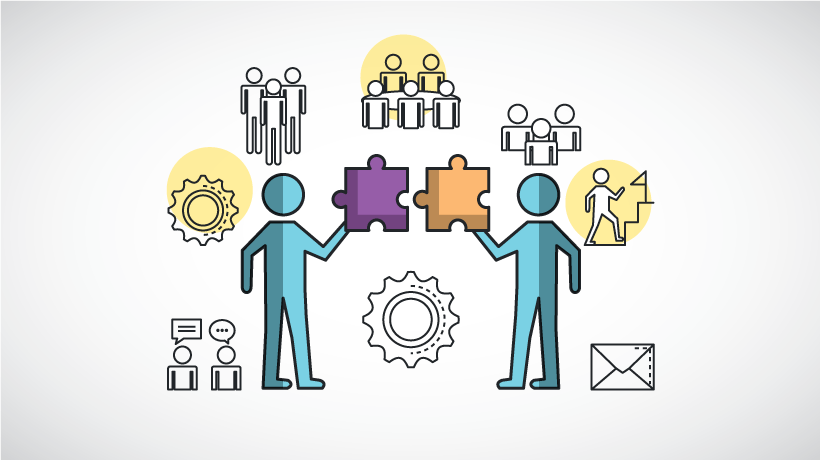Employee Onboarding That Engages
The answer lies in delivering onboarding training that fully engages employees. Unfortunately, what passes for onboarding training often just doesn’t cut it.
In some ways, typical onboarding training confronts the same issues as compliance training. It’s seen primarily as a process to be completed. Once over the new hires are regarded as on board and the next batch can be processed. It’s barely an overstatement to say that for HR onboarding can be a case of ticking the boxes: making sure certain forms are signed, basic training completed, key team members introduced. With such an approach, training becomes more about form and optics than substance.

If HR sees onboarding as a case of ticking the boxes, new hires will, too. For them, onboarding becomes something to be endured, lacking real relevance and to be discarded as soon as it’s completed. It needn’t be that way. And it shouldn’t.
Onboarding can set the standard for subsequent training and career development. It can ensure that new hires are not only welcome, but from the start feel and, critically, act as part of the new team. In short, right from the get-go, new employees need to be engaged. And that means HR and L&D need to be engaged too and provide onboarding training that attracts employees and fully connects them with their new environment.
How LXPs Can Help
Learning Experience Platforms (LXPs) with their focus on the learner and the experience of learning help make onboarding truly engaging. By using an LXP for onboarding you create an attractive environment for learning, introduce the organisation’s culture of learning and make onboarding more targeted and relevant to individual new hires. Moreover, you change the emphasis of onboarding from something that needs to be done and dusted to something more open-ended and useful: a staging post on the development of a career in a new environment.
Even with all the assets and features that LXPs come with, though, you still need to configure it to suit your needs. That means HR and L&D working to adapt the basic requirements of onboarding and translating them into the new platform to maximise the learning experience.
Here are some tips on how to do that.
1. Focus On The Process
Onboarding shouldn’t be episodic. If you treat it as an event, you send a signal that once it’s over it no longer matters. LXPs allow you to make onboarding a more continuous experience. By placing resources and information directly in the hands of new hires and removing the barriers to access that beset LMS and classroom-based training you allow for more direct engagement. You also signal the recognition that not every new employee needs the same level, degree or pace of onboarding. LXPs are very efficient at delivering content and can surface the right information at the right time. This makes onboarding more relevant and less about form filling and box-ticking.
2. Attract Modern Learners
What we need to know may not have changed, but the way we go about finding out about it certainly has. Modern learners are used to finding the right information quickly with the tap on a screen. The LXPs design is influenced by the successful interfaces and features of social media platforms. For new hires, it’s an instantly recognisable environment and sends the signal that they are full participants in their own onboarding.
The LXP is a social and collaborative space as well as a place for learning, facilitating interaction between work colleagues and teams. It can graphically represent the organisation’s structure and culture and allows new employees to explore them easily, helping you achieve a key onboarding goal of seamless integration of new people into your teams.
3. Promote Personalisation
LXPs allow organisations to move away from the restrictive view that onboarding is a one-size-fits-all event. The LXP comes with features—powerful search engine, notifications, recommendations, even a chatbot—that means that information can be presented to learners based on their preferences, queries, and experiences. So, rather than expect mature or experienced new hires to repeat training with which they’re familiar, you can allow them to progress through onboarding at a pace that suits them, while still ensuring (through quizzes and reminders) that they fulfill the main onboarding objectives. For less experienced new hires, the LXP offers refresher and repeat training and a supportive environment.
4. Adopt Microlearning
To achieve more engaging and targeted onboarding training using an LXP, you need to make sure you have the resources and the learning packaged in the right way. Microlearning, the process of chunking and repurposing content into digestible, bite-sized chunks, is the way to go here.
An LXP accommodates a range of content types from traditional PDF documents to multimedia eLearning. It also allows you to curate user-generated content. This means you can have experienced members of the organisation contribute their own personal advice and tips that can help new hires (in video blogs, for example), increasing the sense that onboarding matters and that it’s a key part of moving into the new organisation. All these microlearning assets are searchable and easily accessible.
5. Increase Accessibility
LXPs offer constant access to training resources. They work across platforms and devices, making good use of the near-ubiquity of mobile, smart devices. LXPs recognise that learners carry a learning tool with them all the time, wherever they go. This radically extends the reach of onboarding training and allows new employees to complete training in their own time at their own pace. And if they need to refresh their memories or need more information, they can easily access a piece of microlearning that they can consume in a matter of minutes—at work and on the go. This enhanced access to learning increases employees’ responsibility and control for their own onboarding.
6. Encourage Self-Onboarding
The adoption of personalisation, improved access to training content, a microlearning approach and the LXPs support features, all result in greater learner control and direction. It makes sense then if you use an LXP to onboard your people that you promote self-onboarding.
Empowering employees to direct their own onboarding increases motivation and engagement. They can make the determination of what’s relevant and useful to them at given moments in the process. As they grapple with a new environment and new culture, they can be assured that they will always have access to the information they need when they need it.
A powerful tool here is the chatbot embedded in the LXP that can provide seamless access to content that will fill the gaps in their training. The recommender and notification features mean that where it’s still possible to push necessary information (reminders to complete various tasks, for example) at new hires within the LXP environment. An LXP also provides a wealth of data that can give HR clear and direct insight on a new hire’s onboarding progress trackable through reports and dashboards.
7. Situate Onboarding In The Workflow
Constant access to the supportive and engaging LXP experience allows you to fast-track your new hires into working, allowing them the opportunity to join their new teams and colleagues and not spend the first weeks of their new careers isolated while onboarding training goes on. This means that onboarding is moved directly into the workflow. This not only makes it more relevant it also underlines the message that successful and effective onboarding is regarded as a necessary component of work and that the organisation sees no false dichotomy between learning and working. Learning in the workspace, while doing, is generally regarded as giving training greater impact.
Better Engagement
Making an LXP the prime environment for your training leads to more engaging and effective onboarding. It helps motivate new hires to take direction and control over their own onboarding while at the same time ensuring that key training objectives are met. It addresses the vital requirement to make onboarding memorable and relevant. LXPs promote onboarding as a critical part of new employees’ career development, while making the onboarding process more inclusive and efficient. Download the eBook Power Employee Onboarding Using A Learning Experience Platform (LXP) to discover more about the topic, and join the webinar for supplementary insights.
Sources:
Developing An Effective Leadership Style To Improve Performance And Engagement In The Workplace
How To Create An Agile Business Training Course Keeping Your Learners Engaged
8 Key Elements That Will Help You Develop An Engaging Compliance Training Programme
The HT2 Labs Guide To Learning Experience Platforms
Are You Experienced? An Insight Into Learning Experience Platforms









